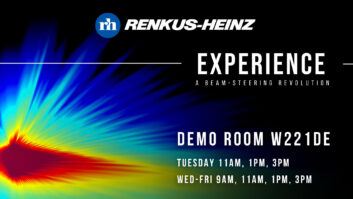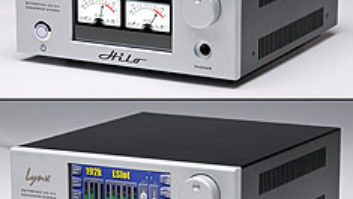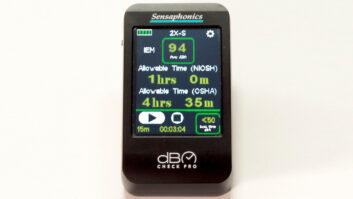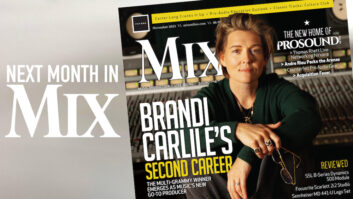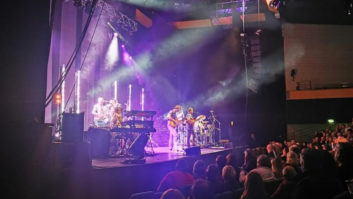Though he was content at JBL and with his Harman career, Scott Leslie was attracted by the professional opportunities presented by his new position as President of Renkus-Heinz (R-H), and by the vision that developed for a future at R-H as more than a replacement manager. “When I first started talking about the possibility with Harro [Heinz, co-founder and chairman] here, I had visions of what was next for Renkus, [which] of course, is growth. Harro is at the point in his life that he wants to step back and not do the day-to-day anymore. He said, ‘There’s so much we could do with this company I’m just no longer the guy that’s going to have the ability to drive on [to that next level].’”

From the vantage point of his experience in acoustics, Leslie said that “there’s nothing worse than going into a bad room,” where point-and-shoot products, and even line array technologies, often fail to solve the problems. “The next thing is to be much more precise and use digital technology to do it, he continued. “And you have to hand it to Harro when several years ago he started investing heavily in beam steering and digital technology. We had to ‘invent this kind of thing;’ there wasn’t a book called ‘How to Create a Beam Steering Loudspeaker Company.’”
The fixed install market is where Leslie places R-H’s strength and its greatest potential for growth, with the House Of Worship market providing a large, double-digit percentage of R-H’s revenue. Leslie illustrated the point by offering that, rather than it being an infrequently chosen custom option, “We sell almost all white speakers. Something like 80% of a certain model of Iconyx were white. When you’re selling the majority of your major product in white what does that tell you?” Leslie stated as a priority the further strengthening of R-H’s position in the markets they serve well, like HOW and live theater, the latter another significant market segment for R-H “that fits us very, very well because it’s fixed install, again…and we have a number of loudspeaker and digital technologies that let us [address the theater market] very well. I don’t think that we’ve anywhere near achieved what kind of market share we can achieve in that exact space.”
Houses Of Worship are the rooms where a system integrator has the least control over shape and size and surface materials, Leslie offered. “If you’re going to Europe and you see all these unique churches, 12th Century, 13th Century, 14th Century, Catholic, Presbyterian, Lutheran, Greek Orthodox, every single one is its own challenge. We have to go to every one and somehow solve that crazy church’s problem. They’re not going to redecorate that church saying, ‘Here, take this wall out.’” Ensuring that churches worldwide know the solutions that R-H offers is a marketing goal of the company.
Leslie offered airports, train stations and subway stations as examples of other applications that can benefit from beam steering. “DSP and clever EQ—everybody does that. But the next chapter is beam steering, because it’s much more precise. You can do some really, really focused things that you can’t do otherwise.” While offering a high reward potential for the application, beam steering is expensive. “You need DSP and an amplifier for every single transducer in a column,” Leslie explained. “An [Iconyx] IC32 has 32 transducers. That’s 32 amplifiers and 32 processors, plus the software. It costs a lot more than traditional ways of solving acoustic problems.”
R-H has been experiencing significant growth in Europe, 58% last year, according to Leslie. “I don’t think [many] American companies, when there are so many very good European brands, grow their market that much in Europe. But clearly we solve a problem which other people don’t.” Even with light European marketing efforts, Leslie says the word has gotten out in Europe of what R-H technology offers. “I believe that our market share in respect to the market available is very small. And so all we have to do is grow our market share to some reasonable amount and we’ll just keep going up and up.”
Renkus-Heinz does not currently service the retail market, as do a number of the high volume manufacturers. “The problem that they’re trying to solve in that market is to get somebody off the street to come in, buy a product and go out the door. They’re not trying to solve an acoustic problem; they’re trying to solve a sales problem. ‘How much of this can I push?’ That’s not the business we’re in today.”
For very large installs, Leslie offered the R-H Varia system as a solution, “Column speakers, like the Iconyx, take us to a certain point. When you need to get beyond that point you need more full range, more SPL, then you want to move towards a more line array type of product. Varia lets you mix ‘n’ match pieces that you can construct and do acoustically with acoustic beam steering what we do in digital beam steering.” Though R-H is not an unknown brand in the touring market, Leslie said the Varia line is firmly aimed at fixed install. “For fixed install, when you need line arrays and you talk to any of the line array companies, they’ll all tell you that they address both the fixed install market and the tour market. Our experts at Renkus-Heinz, as well as our reps, are set up to sell and help configure fixed install. Now if some touring or rental company looked at the [options and said] ‘that solves a problem for me’ and they want to buy it, we’ll sell it.” He concluded that the touring loudspeaker market is “a very crowded space right now…We want people to say ‘I need to understand emergency evacuation better, who do I talk to?’ Well, ‘Talk to the guys at Renkus Heinz, they know that business.’ ‘I need to understand house of worship and how I get around all the acoustic challenges of the typical church?’ ‘Talk to Renkus-Heinz because they’re good at it.’”
Customer education is another planned focus for R-H, said Leslie. “I use an analogy for the light bulb. For the last 70-80 years if you needed a light bulb you chose from a 30 watt, a 60 watt and 100 watt. And you plugged it in. Nobody needed to have any other information. Then in the last years comes compact fluorescent, LED, neon—different choices. And now electricians don’t know what to do. The homeowner doesn’t know what to do.
“It’s not simple anymore. Loudspeakers for many, many years were very simple. You just bought the frequency range you wanted and you kind of pointed it in the direction that you thought it would go. Well, those didn’t solve really, really hard acoustic problems. Now, we’re having to solve them, it’s not easy. So what we’d like to do is engage our reps and distributors to help us educate the customers. To help them go out there and say here are ways to address that problem. And so we want to start by educating [the reps and distributors] and then have them educate the consultants and the end users, contractors. We want to get closer to the consultants and find out what’s in their head with the challenges they’re seeing and see if we can help consultants earn more business…[That’s] kind of a long-winded way of saying education is the way we’re going to really grow this thing.”
Asked where he sees R-H needing to focus in terms of global territories, Leslie answered, “Everywhere!” He laughed, then elaborated, “Anywhere that you see strong religious movement, like the Middle East and Asia, we want to take our strengths to those areas and focus. So the Middle East and Asia, for sure, will be [areas where we’ll work for] big growth. I want to focus some more in Europe, too. Because we’ve seen by putting in a little attention, [Europe has] gone from a really small amount of our business to more and more, and we need to keep going there.”
A shorter version of this story appears in the March 2013 issue of Pro Sound News.
